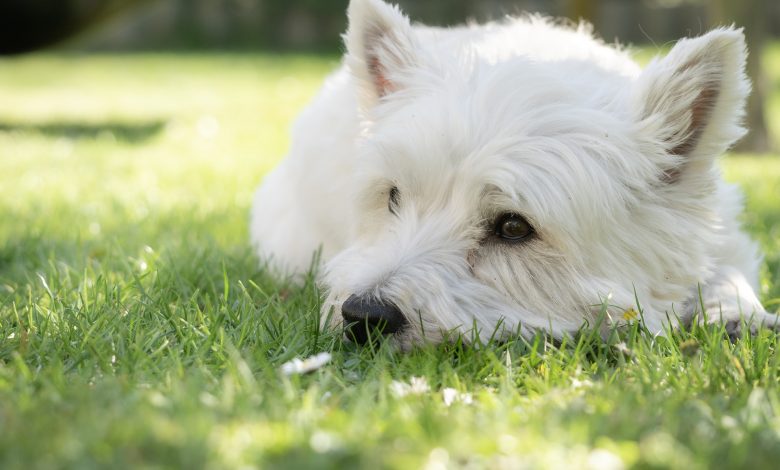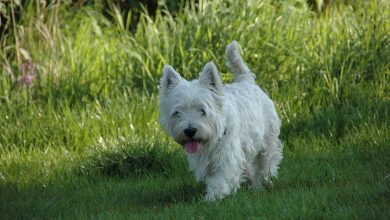Summer Seasonal Symptoms
What’s the difference between heat stroke and dehydration? Faye Andrews explains what to watch out for and how to keep your westie cool.
With British Summertime supposedly on the horizon now is the time to be aware of those seasonal illnesses that can be fatal to our furry companions. Admittedly at present it doesn’t seem to be too hot, but we all know that can change at a drop of a hat!
Most owners are all too familiar with things like tick season, but how much is known about heat stroke and dehydration? Can you recognise the symptoms, and do you know how to prevent it?
Let’s start with some observations about heat stroke and/or dehydration.
Heat Stroke
Overweight, thick coated or flat faced breeds are more prone to heat stroke.
While we cannot do much about the flat faced breeds we can help with both obesity/overweight and thick coats.
If your dog has a thick coat, then a trip to a good groomer to either thin the coat or a good trim is important for the summer months.
If the issue is obesity, please DO NOT try to increase your companion’s exercise during the hot months in a bid to help them lose weight…this should really have been done before now, but what you can do is decrease their calorie intake. During the hot months, our four-legged friends will be less active and therefore need less calories.
Exercise
Stick to the coolest parts of the day, either early morning or late afternoon/evening.
Keep strenuous exercise to a minimum and have plenty of fresh water with you when out walking.
Remember if it is too hot to keep the palm of your hand on the pavement for 15 seconds, then it is too hot for your dog to walk on. This will help prevent footpad burns.
Water
Make sure your dog always has access to fresh water and keep it in a shady area.
During the hot months it is very easy for bacteria to grow so make sure the water bowl is cleaned regularly.
DO NOT wait for your dog to become thirsty on a walk, keep them hydrated by encouraging them to drink little and often.
Dogs (and cats) are also prone to sunburn, especially those with thin or white fur. As with us, it can cause red inflamed skin which is painful and irritated. It can result in scaly skin and hair/fur loss. Use a pet specific sun cream and apply it to their nose and ears.
Whether out for the day or just relaxing at home always make sure your dog has somewhere cool out of direct sunlight to relax in. The area should have ample airflow and remain ventilated throughout the day.
The Difference Between Heatstroke and Dehydration
Heat stroke occurs when the core body temperature exceeds the normal range and the ability of the pet to lose heat and cool itself down.
Symptoms
- Distressed breathing
- Rapid pulse
- Heavy panting
- Bright red tongue
- Vomiting
- Diarrhoea
- Lethargic and weak
- Collapsed or stumbling
- Seizures
- Muscle tremors
Dehydration
This occurs when the dog loses more water and electrolytes than it is taking. As water plays an important role in virtually every function of the body, dehydration can cause severe issues with internal organs, body temperature, joints and digestion.
The dog’s body naturally loses water throughout the day through:
- Panting
- Breathing
- Urinating
- Defecating
- Evaporation through the paws
This is compensated for when our furry companions eats and drinks. As mentioned earlier dehydration occurs when the fluid intake is less than what they are losing, their body’s blood flow and volume of fluid is reduced which reduces the delivery of oxygen to organs and tissues. Dehydration is a very serious concern as it can lead to kidney failure, loss of consciousness, and in extreme cases it can be fatal.
Symptoms include:
- Loss of skin elasticity (pull lightly on the skin and if it doesn’t readily return back to normal then there is a likelihood of dehydration).
- Xerostomia, gums lose moistness becoming dry and sticky, saliva becomes thick and pasty.
- Loss of appetite
- Panting
- Dry nose
If your dog does suffer from dehydration and it is mild then you can give your dog small amounts of water every few minutes, however if it is severe then they will need to be taken to the vet for intravenous fluids.
There are things that can be done to prevent heatstroke and dehydration and to keep our furry friends cool and comfortable during the hot weather, here are just a few ideas:
- Frozen treat cubes
- Let them play with a cool/damp towel
- Cooling mats
- Fans
- Paddling pools
Hopefully you’re all a little more prepared for the hot weather when it comes to taking care of your Westie. Enjoy the sunshine but remember to keep your Besties safe this summer.
Faye Andrews is a human and canine osteopath. For more information on Faye and her work please visit: www.bodywiseosteopathyuk.co.uk






